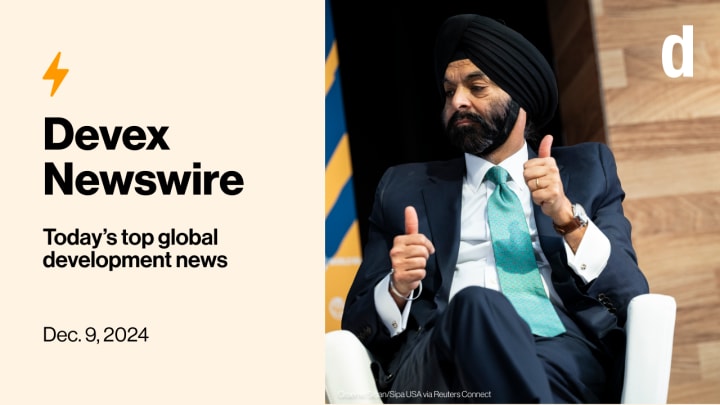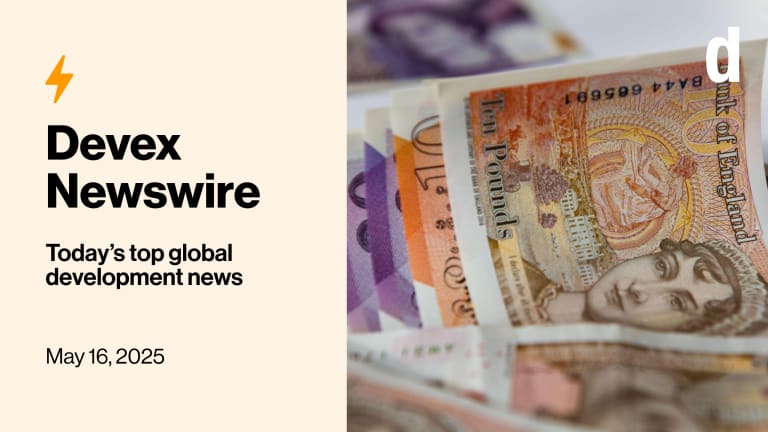Presented by Eleanor Crook Foundation

The World Bank’s lifeline for the lowest-income countries got a big boost, at least according to the bank. To others, that boost was more like a mediocre bump.
Also in today’s edition: Carbon markets take shape, and nutrition yields financial dividends.
+ Coming up: As part of this year’s Global Humanitarian Policy Forum, Devex President and Editor-in-Chief Raj Kumar will lead a fireside chat with Tom Fletcher, the new U.N. relief chief, on Dec. 13 in New York. Stay tuned to the Newswire for the livestream link.
IDAn’t know if it’ll be enough
This is a preview of Newswire
Sign up to this newsletter for an inside look at the biggest stories in global development, in your inbox daily.
World Bank President Ajay Banga declared that he wanted this replenishment cycle of the International Development Association — the bank’s concessional lending arm for the lowest-income countries — to be the biggest ever. He got his wish.
On Friday, the bank announced it had drummed up $23.7 billion in pledges for IDA21. While the final tally broke records, it’s only a marginal increase from the $23.5 billion raised during the last IDA replenishment three years ago — and short of the $27 billion that some advocates had hoped for.
“We think it's very disappointing,” Kate Donald, head of the Washington office at Oxfam International, tells my colleague Jesse Chase-Lubitz. “It's well below what many countries including IDA recipients had been calling for.”
However, because of the World Bank’s ability to leverage funds on capital markets, that $23.7 billion can stretch to $100 billion in grants and loans through mid-2028. The previous figure was $93 billion.
And at a time when donors are pulling back and private credit is drying up — with debt repayment outflows in Africa surpassing private sector investment coming into the continent — IDA is a lifeline for the world’s most vulnerable countries.
“There's no other game in town that does what IDA does,” says Clemence Landers of the Center for Global Development.
In an open letter, Banga acknowledged challenges ahead, including rising debt, but he too pointed out IDA’s unique power and urgent necessity: “This funding will be deployed to support the 78 countries that need it most, providing resources to invest in health, education, infrastructure, and climate resilience; stabilize economies, create jobs, and build the foundation for a better future; and empower nations to navigate an uncertain world and unlock their full potential.”
Read: World Bank calls IDA pledges a win. Critics aren’t so sure
Background reading: IDA replenishment — the money, the odds, the high stakes
+ For more content like this, sign up for Devex Invested, the weekly newsletter on how business, social enterprise, and development finance leaders are tackling global challenges.
Market fluctuations
As Jesse points out, some people view the IDA replenishment as a win, especially considering the economic and political headwinds buffeting donors. However, others see it as a disappointment, akin to the $300 billion climate finance target set at the COP29 U.N. climate summit in Azerbaijan a few weeks ago.
That figure was decried by advocates as woefully inadequate compared to the tremendous costs of climate change. They also lamented how vague the declaration was on where exactly that money would come from.
Concerns about vague promises plagued another COP29 announcement — one that was quickly eclipsed by the final funding announcement but which also has serious implications for how the world copes with climate change.
That agreement formalizes the framework and rules for a global market to buy and sell carbon credits — a scheme that’s been years in the making but has never really taken off coherently.
Carbon markets allow high-emitting countries and corporations, usually in the global north, to buy carbon credits in other places, usually the global south, that fund offsets such as planting trees that remove carbon from the atmosphere.
Supporters of the agreement, known in COP-speak as Article 6, tout its ability to help countries reach their emissions targets while mobilizing billions of dollars to boost green projects and bring in much-needed revenue for lower-income countries.
Critics call it an unregulated, corruption-prone cop-out that lets high-emitters off the hook. Article 6 “has flung open its doors to removal activities that are nothing more than a dangerous distraction,” says Erika Lennon of the Center for International Environmental Law.
Not everyone is as pessimistic.
“While the final text is not perfect, it provides a degree of clarity that has long been absent from international efforts to coordinate emissions trading and carbon crediting,” says Rueban Manokara of the World Wildlife Fund.
Read: Will carbon markets enabled by COP29 really mean $80B for Africa?
Healthy returns
There’s no shortage of pledging conferences and summits looking to win over donor money. There is, however, a shortage of that money to go around.
Brieuc Pont is clear-eyed about the limitations. The French diplomat is secretary-general of the Nutrition for Growth Summit, a major pledging conference that takes place in March.
“People very often hear about the summit when it takes place, when the summit is visible, above the clouds. But below the summit, there’s always a mountain, and right now, we're climbing that mountain with the stakeholders,” he tells Devex Senior Editor Tania Karas.
But it’s a steep climb.
“It's true that the context is challenging, to say the least. When a diplomat says something is challenging, it means impossible. And I'd say indeed the situation has changed since 2021. We have a high-intensity war being waged in Europe, which unleashed not only a regional crisis in Europe, but a security crisis, but also a worldwide food crisis, which induced inflation, and hence a financial crisis,” he says, noting that we are still paying back the debt of the COVID-19 pandemic.
However, he believes there are still a few stones left unturned. One is the financial case advocates can make for nutrition.
Investing $100 million in nutrition-specific or nutrition-sensitive development policies yields $2.3 billion in returns — “that is wealth that can be redistributed or reinvested,” Pont says. “And yet, only 1% of official development aid is nutrition-specific. So there is the challenge to make governments and donors aware that it works. Our strategy is very much involving the development banks. And I'm sure that it's music to the bankers’ ears that you can get so much cost-effectiveness through that kind of investment.”
Read: This French diplomat thinks nutrition is a ‘magic wand’ for development (Pro)
+ Not a Devex Pro member yet? Start your 15-day free trial today to access all our exclusive reporting and analyses, data-driven funding insights, members-only events, the world’s largest global development job board, and more. Check out all the exclusive content available to you.
Opinion corner
• Africa's climate plans dwell too much on emissions cuts over adaptation, according to Dr. Githinji Gitahi, group chief executive officer of Amref Health Africa, who writes: “For many Africans, it’s hard to explain why their leaders prioritize reducing emissions which are rather low and insignificant when the immediate threat of climate change is not their carbon footprint but their vulnerability to its effects.”
• With Donald Trump winning a second term as U.S. president, global development faces a reckoning. The anecdote? Bold ideas “that can inspire a next era of bipartisan, political consensus on global development,” Kimberly Cernak argues. “In Washington, there was an audible sigh of relief within the global development sector on the other side of Trump’s first term — impactful policies and programs largely remained intact. But in the exhale we may have missed a lesson: An era of nostalgia in global development was on its way out.”
• John Plastow, executive director of Frontline AIDS, doesn’t mince words about the implications of a second Trump presidency: “The return of a Donald Trump presidency in the United States is a body blow to the global HIV response, to universal sexual and reproductive health and rights, and to the people and communities who are most impacted by HIV and AIDS … which is why the role of civil society and partners across the globe involved in the fight against the disease is more important now than ever.”
+ Curious about the globaldev community’s perspective on the latest news? Head to our op-eds page for unique insights.
In other news
Opposition forces declared Syria liberated from President Bashar al-Assad’s rule on Sunday. [Al Jazeera]
The climate crisis intensifies as 2024 is set to become the hottest year on record, with last month’s global temperature reaching 1.62 degrees Celsius above preindustrial levels for the first time. [The Guardian]
A Moroccan company is leading Africa's push for medical self-reliance by producing mpox tests amid a continent-wide outbreak. [AP]
Sign up to Newswire for an inside look at the biggest stories in global development.




